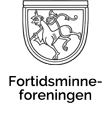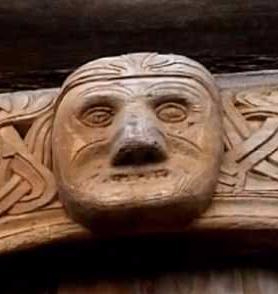 The Norse saga figure Gunnar Gjukesson in the snake pit can be seen in three key woodcarvings in Numedal. These are found in Uvdal stave church, in the main building at Mellom Kravik and at the loft on Nordre Vangestad in Flesberg.
The Norse saga figure Gunnar Gjukesson in the snake pit can be seen in three key woodcarvings in Numedal. These are found in Uvdal stave church, in the main building at Mellom Kravik and at the loft on Nordre Vangestad in Flesberg.
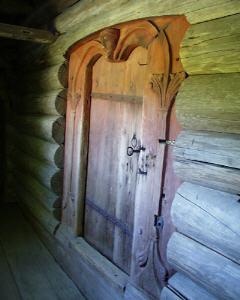 The portal on the 2nd floor at Vangestad. Photo: Eva Aalmo Berthelsen
The portal on the 2nd floor at Vangestad. Photo: Eva Aalmo Berthelsen
The story of Gunnar Gjukesson is from the saga of Sigurd Fåvnesbane in the norse poetry of “Edda”. The legend originated in the Germanic cultural area as early as the 8. and 9. century and was still popular in Norway during the Middle Ages. This is not only depicted in profane woodcarving-art, where design from the pagan conceptions continued into the Christianization in the 11. century, but also in church decorations in stave churches from the 12. and 13. century. This shows that the saga about Sigurd, like many other pagan myths and legends, survived the christening and was adapted to the new faith.
Dr. phil. Erla Bergendahl Hohler notes that of 138 preserved stave church portals in Norway there are only two who have typical biblical motifs. The others have dragon- and vine ornaments, some of them in combination with motifs taken from the Norse heroic prose.
Among motifs with pagan origins, the Sigurd poetry is often repeated. One of the most common is it where Sigurd kills the dragon Fafnir with his sword. Sigurd dragon slayer has by many historians been seen as a parallel to the biblical dragon slayer St. George and the Christian Crusaders. One such was Lorenz Dietrichson, art historian who is considered Norway’s first stave church researcher. Other researchers have seen a correlation between Sigurd dragon slayer and St. Michael, the angel that killed Satan in the form of a dragon. What Sigurd dragon slayer, St. George and St. Michael have in common is that they all represent good forces in their fight against evil.
Norwegian stave churches with design from the Sigurd theme
The portal from Hylestad stave church in Valle, Setesdal is considered the most important woodcarving work with motifs from the Sigurd Poems. The portal has nine motifs from the legend, among them Regin forging Sigurd’s sword, Sigurd killing Fafnir, Sigurd killing Regin and Gunnar in the snake pit. The portal is detailed naturalistic carved, and is surely made by a professional woodcarver, as are many other portals in Norwegian stave churches. A portal with similar Sigurd design in the stave church in Austad, Setesdal is said to be carved by the same vagrant woodcarver.
Mæl stave church in Tinn is another important stave church with portal decorations from the Sigurd saga. This church was dismantled in 1839 and the portal was moved to a barn at the farm “Moland”. The portal was recovered in 1920 and transferred to Tinn Folk Museum in Telemark. The left column is adorned with vines in the Romanesque style, while the right has seven designs from the Sigurd story. Among these, we once again find the most important events of the legend, with Regin forging Sigurd’s sword and Sigurd killing Fafnir as the most important.
Also from Vegusdal stave church in Setesdal, Nesland stave church in Telemark and Lardal stave church in Svarstad, Vestfold are preserved portals with motifs taken from the Sigurd saga. This shows that the main area for the Sigurd motives in Norwegian medieval woodcarving ranges from Setesdal in the west to Lågendalen and Numedal in the east. In our district, Lardal stave church has the greatest number of motifs taken from the Sigurd saga. This stave church was dismantled in 1657, but the richly carved portal were taken care of and recovered at the farm Gavlestad in 1852. Both columns have circular medallions with figure design surrounded by vines in the Romanesque style. The left side is adorned with three medieval lions, while the right side has five scenes from the Sigurd saga, including Regin forging the sword, Sigurd killing Fafnir and Oter with the gold treasure.
Designs from Sigurd dragon slayer saga in Numedal
Gunnar Gjukesson in the snake pit is the only design from the Sigurd saga that are preserved in medieval woodcarving in Numedal. Gunnar was king of the Goths and Sigurd's brother in law but also the one who caused Sigurd's death. After a complicated and bloody love drama, Gunnar made his brother Guttorm kill Sigurd. Gunnar then took the gold treasure “Fåvnesgullet” which had a curse to it. Sigurd had originally got the treasure when he killed Fafnir, and it was the curse that caused the tragedies of those who had the gold. The last one trying to control the treasure was Atle, Gunnar's brother in law. Gunnar refused to tell Atle where the treasure was hidden, and Atle placed him in a snake pit. Here he had to stand with his arms tied behind his back, while he played on a harp with his feet. All the snakes except one fell asleep by Gunnar’s beautiful harp music. This snake gnawed into his chest and struck him in the heart.
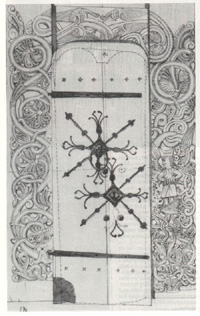 West Portal in Uvdal stave church. Einar Oskar Schou 1901. Drawing at the Directorate for Cultural HeritageFolk Art Researcher Roar Haugelid wrote that clergy in retrospect may have interpreted the Gunnar scene in church art as a symbol of the struggle against evil forces. But for ordinary people in the Middle Ages, Gunnar was a figure they recognized from the oral traditions, and Gunnar had no connection to their Christian faith.
West Portal in Uvdal stave church. Einar Oskar Schou 1901. Drawing at the Directorate for Cultural HeritageFolk Art Researcher Roar Haugelid wrote that clergy in retrospect may have interpreted the Gunnar scene in church art as a symbol of the struggle against evil forces. But for ordinary people in the Middle Ages, Gunnar was a figure they recognized from the oral traditions, and Gunnar had no connection to their Christian faith.
There is also a connection to the legend about Gunnar in the snake pit in the Greek Orpheus myth. Orpheus was a exceptional lyre player, and his skillful play captivated both animals, plants, gods and humans. Orpheus has subsequently been identified with the biblical King David, who also was known for his persuasive harp playing.
The west portal in Uvdal stave church
Uvdal stave church is the only medieval church with design from the Sigurd saga in Numedal. The church got a new porch in the 1300s and it is believed that the west portal was carved at the same time. We can see a design of Gunnar in the snake pit in a central location between the stems on the right column. Gunnar plays the harp with his feet, while the snake that is about to give him the lethal attack is peeping out from his left armpit. The other snakes and a dragon are coiling around him, but are not able to attack the legendary hero as long as he plays the harp.
The Gunnar figure is quite naive depicted, with his head in profile and body shown straight up. The small, stocky and somewhat flattened body is dressed in a pleated coat, while his large head has curly hair and a two-cornered hat. Some have interpreted Gunnar’s special headgear as a bishop's miter, while others believe it is a royal crown since he in the Edda poems are the king of Goths. It may also be a typical medieval hat for men. This kind of hats were actually used in Setesdal until the 1800s.
The western Portal in Uvdal stave church is supposed to be carved as late as the 14th century, while the other medieval carvings in the stave church is from the 13th century Roar Haugelid believes that the relatively flat cutouts and the somewhat naive character representation is pointing toward the post-reformation folk art. There is little to suggest that this is done by a professional woodcarver as in Setesdal. Erla B. Hohler is also among those who believe that the portal must be carved by a local folk artist, and justifies this by the stylized design rendering and the late dating.
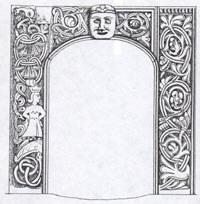 The Kravik portal Illustration by Nicolay Nicolaysen.
The Kravik portal Illustration by Nicolay Nicolaysen.
The Portal on Mellom Kravik
The design of Gunnar in the snake pit on the portal at Mellom Kravik has much in common with the motifs in Uvdal stave church. It is therefore interesting that the profane Kravik portal is far older than the Uvdal portal. The main building at Mellom Kravik was originally a medieval farmhouse, and is today Norway's oldest inhabited house. Dendrochronological investigations shows that the timber was cut as early as the mid-1100s, and the portal is arguably the oldest with motifs from the Sigurd saga in Numedal.
The Kravik portal has, as does the Uvdal portal, Romanesque floral patterns and depicts Gunnar Gjukesson playing the harp with his feet. Gunnar is located on the left column, with his head facing the doorway. Although the Gunnar design is almost worn away, we can still see that the expression has been more realistic and detailed than in Uvdal stave church. This also applies to the other ornaments on the portal. In addition to the Gunnar design, the portal has Romanesque palmettes and floral patterns. A small fabled animal is placed in the upper left corner. In the middle of the curved section above the entrance, there is a masked face surrounded by acanthus leaves. Some believe that the mask is depicting the Norse God Odin, and that his task was to guard the building. Similar masks are found at several other non-ecclesiastical medieval buildings in Norway, with the Tveito loft from Hovin as a primary example. These masks also have much in common with those found at the top of the poles in many stave churches.
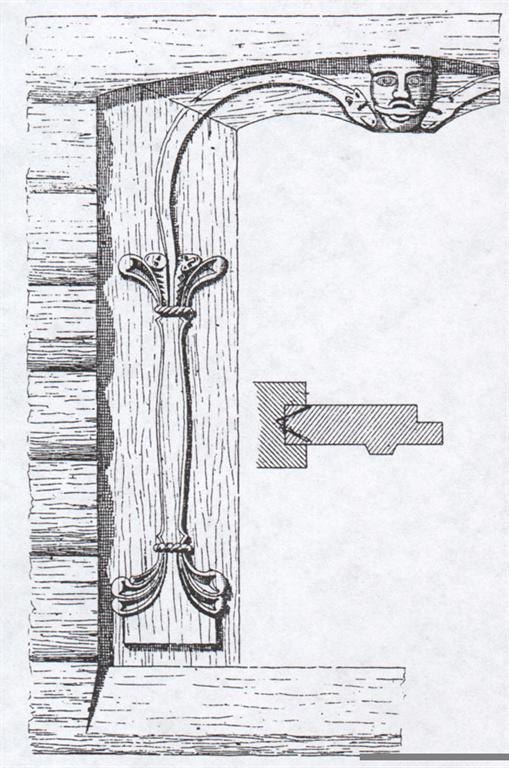 The portal on the second floor at the Vangestad loft. Illustration by Nicolay Nicolaysen. The Portal on Nordre Vangestad
The portal on the second floor at the Vangestad loft. Illustration by Nicolay Nicolaysen. The Portal on Nordre Vangestad
The portals of Nordre Vangestad has a unique representation of Gunnar Gjukesson in the snake pit. The portal on the ground floor has columns designed as flat beam with base and column headers. Each column head consists of a stylized snake encircled by two flattened leaves. The snakes coils toward a mask placed in the middle, above the door, just like the mask on Kravik. The lower part of the mask has been cut away because the folks at Vangestad was tired of bumping their heads every time they entered the store room.
The portal on the second floor is much more detailed than the portal on the ground floor, although the motive is the same. Two snakes coils out from their respective column head and attack a face centered over the door. The Romanesque mask has a tape across the mouth, making it seem as if it is gagged.
Although the masks in the Vangestad portals are placed in a similar way as the mask at Mellom Kravik and several other medieval buildings in Norway, it is still likely that in it is not related to the god Odin in this case. Most likely it is a unique variation on the motif Gunnar Gjukesson in the snake pit. On the second floor there are several smaller snakes among the Romanesque foliage in the column head on the left side of the door. These snakes have a marked zigzag pattern on their back, obviously the snake most people knew - the adder.
Scholars disagree about when the portals in the attic in Nordre Vangestad have been made, although it must have be quite recent. Arne Berg believes they may be from the 14th century, Per Gjerder from the 15th and Johan Meyer as late as the 16th. Nevertheless, the portal have been carved by a local woodcarver who have interpreted the story of Gunnar in the snake pit in his own way. But it is also likely that the dragon battles on the stave church portals have been an important source of inspiration. In Flesberg stave few kilometers further up the valley, we find a similar design where a large centered dragon is being attacked by two smaller dragons on either side.
Per Gjerder also sees a connection between the Vangestad portals and stone church portals in Denmark. The church in Søndre Onsild is supposed to have a stone portal with many similarities to the wooden portals at Vangestad. Gjerder also points out that the famous Talisman portal in Baghdad has an motif with a man in the middle attacked by snakes on both sides. This shows that many of the subjects in the Norwegian medieval art was a repeated motif, and that they were not unique to the Norse culture. The Greek Orpheus myth also supports this.
It is not only in the portals scenes from the Sigurd saga was used. The motifs are also found on furniture and artifacts, for example on a chair in Heddal stave church. This beautiful chair has several designs from the legend, with Gunnar Gjukesson in snake pit located on the back of the chair.
Erla Bergendahl Hohler is among those who believe designs from the Sigurd saga may have spread from textiles and older paintings. She finds it likely that the motifs were first used profanely, especially in the houses of the aristocracy and the local upper class. In Numedal, the portal of the old farm Mellom Kravik is a unique example of such early non-ecclesiastical design from the Sigurd saga.








